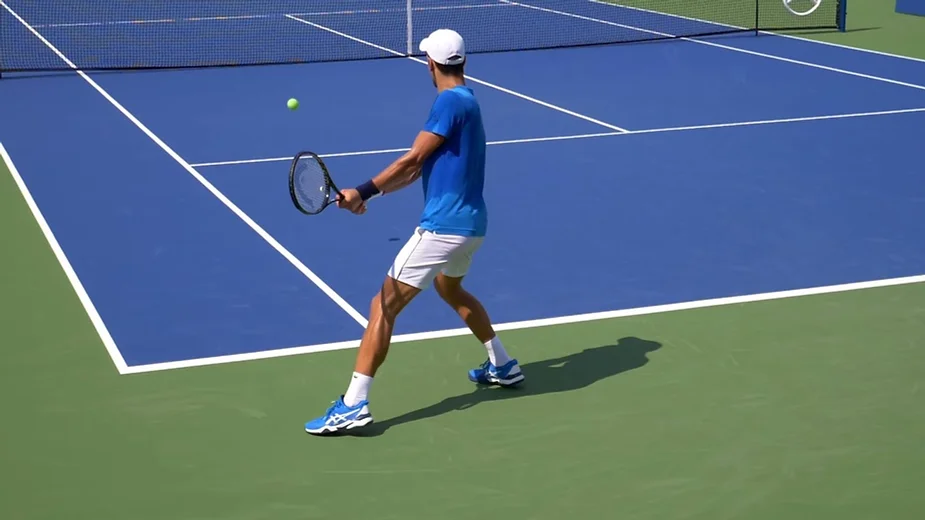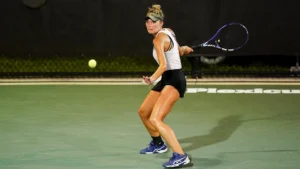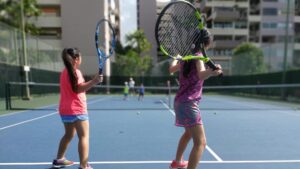Introduction
Let’s take a look at a tennis guide that will improve your return game. Whether you’re returning a powerful serve or a tricky kick serve, getting the ball back successfully is one of the most important aspects of your return game.
It’s not just about hitting the ball, but also about placing it strategically to gain an advantage over your opponent. In this guide, we will explore different techniques and strategies to help you return the serve with precision and control. So, buckle up and get ready to up your return game!
Tennis Return of Serve
The serve is one of the most important shots in tennis, requiring precision, accuracy, and timing. As a result, it’s essential to block out any distractions when you’re on the tennis court and focus solely on the task at hand.
To ensure your return of serve isn’t affected by outside influences, use relaxation techniques such as deep breathing and visualization to clear your mind and remain present in the moment. Additionally, give yourself positive affirmations before each point – reminding yourself of what you’re aiming to achieve can help reduce stress and pressure.
It’s also important to practice mindfulness when facing tough opponents. Be aware of your movements and emotions during matches, and recognize when your concentration starts to drift. Find ways to stay focused on the match at hand and make sure your performance doesn’t suffer as a result of factors outside of your control.
With hard work and dedication, tuning out distractions and honing your return of serve can become second nature. Block out all the noise and stay fully committed to perfecting your technique – focus is the key to success!
The Best Return Of Serve Tactics
When it comes to serving, the best return tactics often come down to smart positioning and anticipation. By standing in the right place on the tennis court, you can make yourself a difficult target for your opponent’s return. This way, you increase the chances that their shot will be off-target while giving yourself time to ready your own return.
Anticipation is key when defending against a serve. Knowing when to move and when to stay still can be the difference between success and failure. By reading the motion of your opponent’s body and the trajectory of the ball, you can determine the type of return they’ll attempt and adjust your position accordingly.
To fully master the art of returning serve, practice regularly and experiment with different techniques until you find what works best for you. With the right attitude and dedication, you’ll soon be able to turn even the most daunting serves into easy points!
Return of First serve
The return of first-serve is an incredible opportunity to up your game and reignite your passion for tennis. After months of waiting, you can take the court with newfound vigor. Serve hard and fast, making sure the ball lands just out of reach of your opponents – and some incredible rallies will commence. Experience a feeling of rhythm and energy like never before as you hit groundstrokes and lobs with unparalleled accuracy.
Practice hard in anticipation of this momentous event, so that when it arrives you’ll be able to dazzle them all with your skill. As you glide effortlessly across the court, don’t forget to enjoy the experience; savor each point as if it were your last. The return of first-serve may just be the beginning; you could soon find yourself in the thick of a championship match. So make sure you take charge at the start – because your opponent will no doubt be ready to do the same!
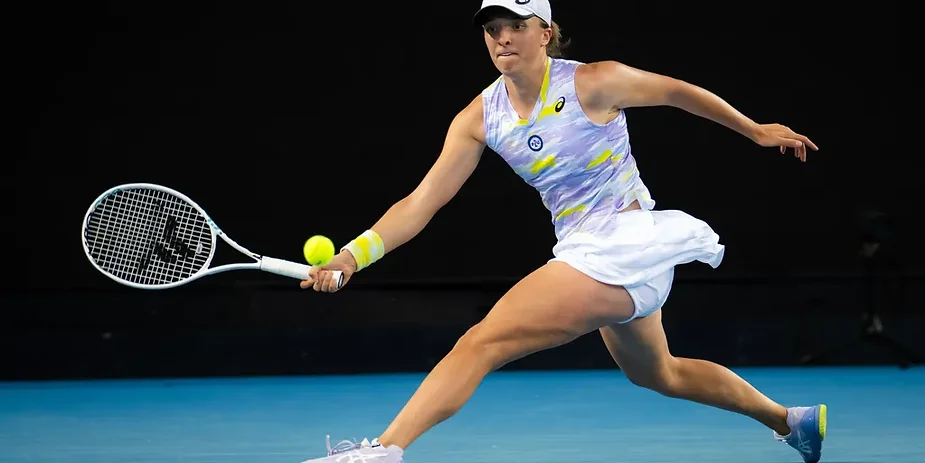
Returning From The Ad Court in Doubles
Returning from the Ad Court in doubles requires precision timing and execution. Begin by positioning one player on the baseline and the other near the net post on her own side of the court. As the serve is made, the tennis player at the net should move to the center of the court, ready to make a crosscourt return. The player at the baseline should stand towards their partner’s forehand corner, ready to receive a deep return.
Once the server has hit the ball, the player at the net should take two quick steps back, using their natural momentum to help them reach for the ball. With an exaggerated backward swing, they should volley the ball across the court with speed and depth. Meanwhile, the player at the baseline should be getting into position and ready to take their return. For optimum accuracy, they should aim for their partner’s weaker side or near the opposite service box diagonally.
With fast-paced exchanges like these, it’s essential that players stay light on their feet and maintain eye contact with their partner throughout. To master this returning technique, practice makes perfect—so hop onto the courts and get rallying!
Preparing for A Tennis Serve Return – Footwork and Racket-Work
When it comes to tennis, every return needs lightning-quick footwork and perfect racket work. Your feet are the foundation on which your game is built. To stay a step ahead of your opponent, you must move quickly and decisively– not shying away from strong cuts or standing in place too long. As soon as you spot an incoming serve, prime your feet for action.
Your racket is the other essential tool in executing your return. Be sure to position it correctly, with your arm at a 90-degree angle and your wrist firm. Ready your grip so that when the ball comes striking through the air, you’ll be able to generate maximum power and spin. Make sure you contact the ball in the sweet spot of your frame, focusing on both accuracy and placement of the shot.
At the end of the day, it’s all about outsmarting your adversary through both footwork and racket work. Master the art of the tennis serve return, and your opponents simply won’t know what hit them!
The Importance of the Split Step
The split step is one of the most critical components of a successful return of serve, yet many players overlook it. The split step involves quickly stepping towards the ball right as your opponent serves and gives you a huge advantage. By propelling yourself forward, you can get to the ball much faster, giving you more time to assess the trajectory and spin of the ball and position your body accordingly. The split step also helps with your accuracy – it helps you stay on balance and aim your shots with precision.
But it’s not just about technique – it’s about sharpening your mental game too. The split step forces you to make quick decisions, relying on instinct as much as technical know-how. This helps build your confidence and focus on the court, helping you become a smarter and more strategic player.
Next time you’re faced with an opponent’s serve, remember the importance of the split step in perfecting your return. With practice, you can master this key technique and take your game to the next level.
Common Mistakes While Returning Serve
When it comes to returning serve, it can be easy to make a few common mistakes that could cost you the match if you’re not careful. Here’s how to avoid them:
1. Not Picking The Right Racquet
Choose a tennis racket with the right weight and balance for your shot selection and playing style; this will help ensure you have the control and power you need to get the most out of each return.
2. Taking Too Long
Once the serve is headed your way, act quickly and decisively. Taking too long to line up your return can give the server the advantage and could lead to a weak, inaccurate shot.
3. Placing Your Return In The Wrong Spot
Return serves should be placed strategically so they are more difficult to attack; this means aiming towards corners of the court instead of down the center.
By properly assessing the situation and avoiding these common mistakes, you’ll be able to effectively employ your return skills and put yourself in a good position to win the point. So stay focused and confident, and take control of the serve exchange.
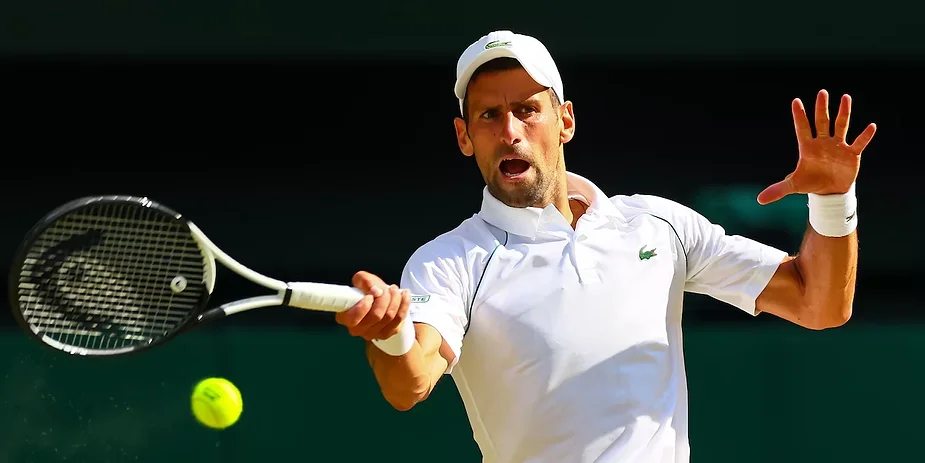
Return Technique: The Backswing, Contact, & Follow Through
The backswing is the precursor to a successful shot and an essential part of your golf game. You want to use your muscles efficiently and keep your swing smooth – this will help you generate more power and consistency. Start with a wide stance and lightly grip the club. Take a deep breath, relax, and turn your body away from the ball as you swing the club back in an arc.
Contact is the moment when you make contact with the ball. Focus on keeping your head down and your arms straight while maintaining the same tempo from the backswing. Be sure to rotate your hips and shoulders through the shot to create speed and give it an extra oomph.
Finally, follow-through is the final stage of your swing. Continue to rotate your hips and shoulders after the shot, as if you are completing a full circle. This helps transfer all of your energy into the ball with maximum power and precision. With practice, you’ll be able to master the backswing, contact, and follow-through for a perfect shot!
7 Steps To A Great Return Of Serve: Technique & Fundamentals
If you’re serious about tennis, then you know that having a great return of serve is essential for playing your best game. But too often, players get caught up in the heat of the moment and forget to focus on technique and fundamentals. Make sure you don’t fall into this trap – follow these seven steps to build a powerful, effective return of serve.
Step one, stay balanced as you prepare your stance.
Step two, use the Continental grip or semi-Western for more control over your shots.
Step three, keep your head steady and focused on the ball at all times.
Step four, hit through the ball with plenty of power.
Step five, move quickly to the net after your shot.
Step six, switch your racket hand from forehand to backhand depending on where the ball is headed.
Finally, practice regularly to perfect your technique and boost confidence in yourself.
With a few simple adjustments to your routine, you can make your return of serve an unbeatable weapon on the court. Now go out there and start winning!
Blocking Out Distractions
As you step onto the court, the outside world recedes into oblivion. Your sole focus is on your return of serve — feeding the opposing player’s ball back with precision and power. But, in order to make the most of your service game, it requires that you first block out all distractions.
Your surroundings become a blur, allowing you to hone in on the moment and completely clear your head. Nourish your mind with positive thoughts and imagine yourself successfully hitting back each stroke. Make sure to keep your sights trained on the ball – its movement, it’s spin – so that you can react more quickly when it’s time to return the shot.
With all these steps combined, you can improve your return of serve by remaining calm and collected under pressure. So take control, stay focused, and let the world drift away as you ace your next return!
Conclusion
The return of serve is one of the most crucial aspects in tennis matches. It requires a combination of tennis technique and strategic thinking to anticipate and successfully return the opponent’s serve. In this guide, we will focus on the importance of the return of serve and provide valuable tips to improve your tennis game.
One of the best strategies is to take a step forward just as the serve is coming, allowing you to gain control over the point and put pressure on your opponent. Additionally, mastering the slice serve return can give you an advantage and potentially lead to a break of serve. So let’s dive in and enhance your tennis skills on the return of serve!


